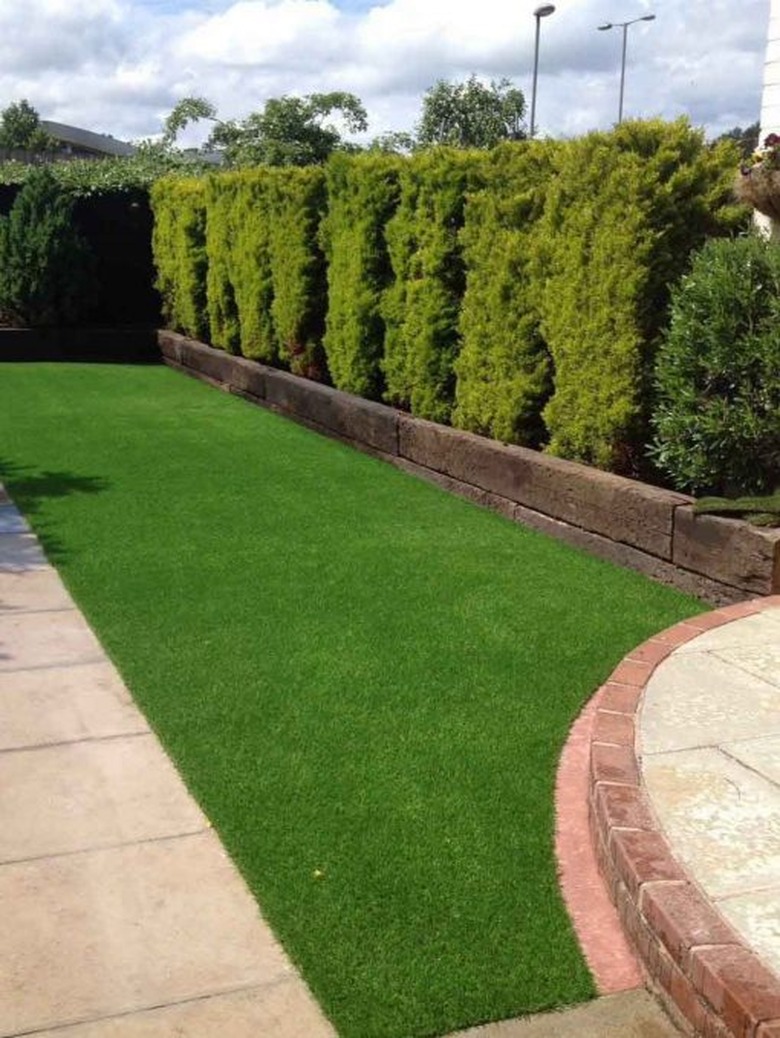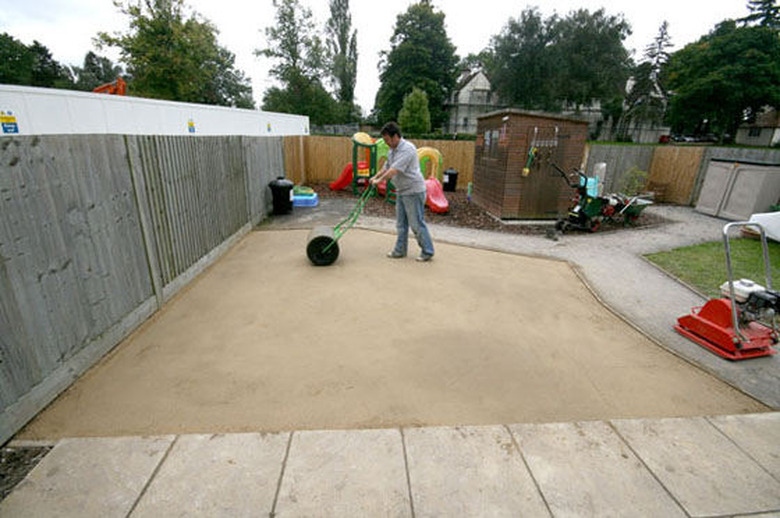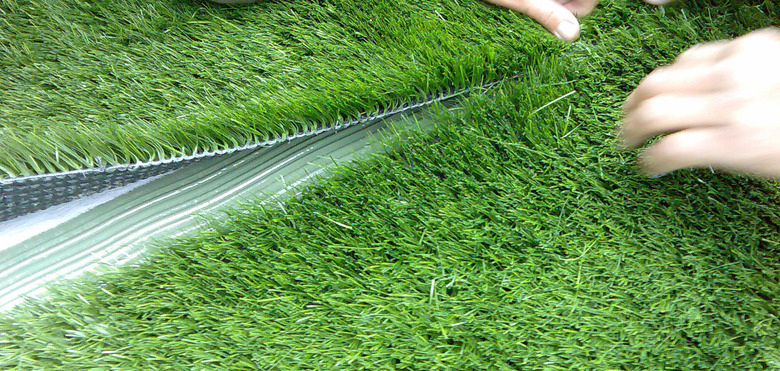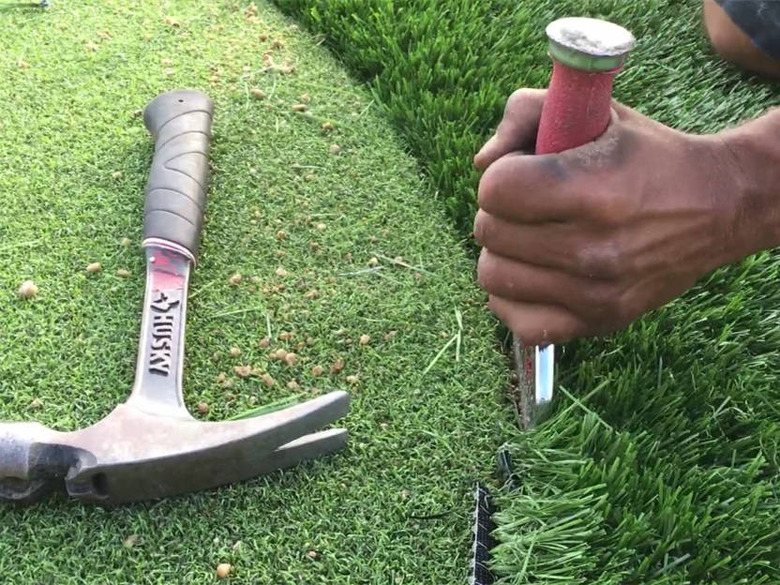How To Install Artificial Grass
Perhaps you live in a community that restricts lawn watering, or maybe you're just tired of wasting all that water on grass. Or maybe your growing conditions aren't conducive to a thick lawn of turf grass. If any of these conditions match your situation, an artificial lawn may be just what you need. Artificial grass is not without drawbacks, but on the plus side, it's virtually maintenance free and stays green for up 25 years. These days, most artificial grass is made from recycled plastic, so it's an environmentally friendly product—at least until it someday ends up as non-biodegradable landfill.
So what's not to like? Well, one problem is that artificial grass can get so hot in direct sunlight that it has been known to melt shoes. Another is that, while it may drain liquids, solids won't penetrate, so waste from pets or any wild animals in the area has to be cleaned by hand. One more thing: Artificial grass blocks the soil underneath from sun and rain and renders it all but barren. That can be considered a benefit, because it means weeds won't grow; but it can also be a problem if you ever decide you want to remove the artificial grass and grow something.
Once you've assessed the pros and cons of artificial grass and decided that it suits your needs, you won't have any trouble finding it. It's available at big box stores, such as Lowes and Home Depot, as well as at specialty artificial turf outlets and even at some outlets that sell real turf. You can usually get it installed professionally, but if you want to do the job yourself, there's no reason why you shouldn't. The process is a little like laying carpet.
Preparing the Ground for Artificial Grass
Preparing the Ground for Artificial Grass
Most of the work involved with installing an artificial lawn goes into preparing the area to be covered. The preparation procedure is a multi-step one that may require machinery, depending on the size of the area, the topography and the soil.
1. Clear Existing Vegetation
Remove all existing turf and dig up all the weeds. Treat the area with pre-emergent weed killer to prevent new growth. Pay particular attention to the edges of the area, where weeds may still get a little sunlight.
2. Level the Ground
The area on which you lay the turf should be flat, so knock down any high areas and fill depressions with soil. After you're done digging, turning and moving the soil, compact it with a plate compactor. Ideally, the area should be flat with a 1 percent grade toward the edges so water can drain off the lawn.
3. Border the Area
Install a border of 3-inch wood or plastic bender board around the entire area to be turfed. The purpose of the border is to contain the base rock, which comes next.
4. Create the Base
Cover the area to be turfed with a weed block membrane to separate the soil from a layer of base rock, then drop in enough 1/4- to 3/4-inch crushed drain rock to create a uniform base 1 to 2 inches thick. Use coarse 3/4-inch drain rock if the soil drains poorly. Otherwise, use finer drain rock, but do not use rounded rock, such as pea gravel, which will create an unstable base.
Compact the base rock after raking it level, then cover it with a layer of sand. Finish off by installing another weed membrane on top of the sand.
Measuring, Cutting and Joining Artificial Grass
Measuring, Cutting and Joining Artificial Grass
One of the mistakes DIY turf installers make most frequently, according to one professional, is to make inaccurate measurements of the area to be covered, ending up with insufficient turf. They then buy more turf from a different batch that doesn't quite match the original for color and texture.
Check your measurements carefully, then recheck them. If the area isn't rectangular or another regular shape, make a diagram and divide it into regular shapes that you can measure. You want to buy enough turf to overlap the edges by about 6 inches so you have enough to tuck against the border. Depending on the turf, you may also need to buy fixing pins to hold it down, and if the area is wider than a single roll, you'll need jointing tape and adhesive to join the rolls.
Joining two sections of artificial turf is just like joining two sections of carpet. You need a straight edge on both sections to be joined, so if you don't use the factory edge, cut along the stitch line with a sharp utility knife. Butt together the two sections to be joined and do whatever trimming is necessary to make the seam disappear. Fold back both sections, lay jointing tape underneath the seam and apply adhesive to the tape with a tube or caulk gun. When you fold lay the turf flat on the tape, the joint will be permanent.
Laying Artificial Turf
Laying Artificial Turf
The basic procedure for installing the turf is straightforward. You simply lay it over the area to be covered, trim the edges, and, if necessary, drive pins to hold it down and keep it from bunching up. Pros add a few refinements to this procedure to maximize the life of the turf and achieve the appearance of real grass.
- Artificial turf has a visible "grain" formed by the natural bend of the blades. If the blades of adjacent pieces bend in different directions, the difference is noticeable. Avoid this by installing all pieces with the blades bending in the same direction, then rake the entire lawn in the grain direction when you're done installing it.
- Cut the edges of the turf about 2 inches past the borders, then tuck the edges underneath the borders, using a putty knife or chisel to force them down. This looks much more natural than stapling the edges to the borders or staking them down.
- Weigh down the turf with filler sand after the installation is complete. This sand, which is coated with ceramic and is completely safe for children and pets, is available where you buy the turf. Infilling with sand is optional, but it's recommended. The sand lengthens the life of the turf and makes it easier to walk on.
Artificial turf requires very little maintenance, but it does require some. If you live in a humid climate, prevent the growth of mold and mildew by spraying the turf with a 1-to-10 mixture of hydrogen peroxide and water every few months. You can also use this mixture to treat active mold. Remove pet deposits promptly to avoid odors, and rake the turf regularly to remove twigs, leaves and other debris, just as you would with a living turf-grass lawn.



